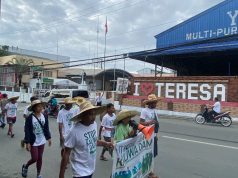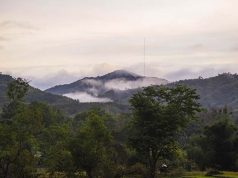
- Dam planned to avert water crisis in Philippine capital
- Kaliwa Dam would flood indigenous mountain land
- Critics urge officials to explore other options
MANILA (Thomson Reuters Foundation) — For thousands of years, the Filipino Dumagat-Remontados Indigenous people have cultivated their lands on the Sierra Madre mountain range. Soon, hundreds of hectares of their forests could be swallowed by a major new river dam.
Officials say the Kaliwa Dam is vital to supply the water-stressed region around the capital Manila, but Indigenous groups say they were not properly consulted in line with the law and the project threatens their traditional way of life.
“We went down from the mountains and walked because our rights were violated during the approval process for the dam,” said Conchita Calzado, an Indigenous elder who last month led about 300 tribe members on a nine-day protest march to Manila.
“We are the communities whose livelihood, culture and sacred land will be directly affected.”
The Metropolitan Waterworks and Sewerage System (MWSS), the government agency in charge of the capital region’s water resources, has said indigenous approval processes were followed and the dam is needed to avert a looming water crisis.
Residents are already experiencing water shortages in Metro Manila, a densely-populated sprawl of 16 adjoined cities.
At present, 90% of the region’s drinking water comes from the 55-year-old Angat Dam which can supply about 4,000 million litres per day.
MWSS says the Kaliwa Dam would improve water security and could supply an extra 600 million litres per day.
The 12.2 billion Philippine pesos ($225 million) project, funded with a loan from China, is set to install a 60-metre high dam on the Kaliwa river in the mountain district of Quezon.
Only 15 Indigenous families would be displaced from their homes as a result and the dam will be managed to prevent flooding, Jose Dorado, an MWSS official supervising the project, told the Thomson Reuters Foundation in an interview.
The Stop Kaliwa Dam campaign, a group of environmental and Indigenous groups, said at least 5,000 tribespeople are situated in the area of the planned dam, about 300 of whom would be directly affected in addition to those displaced.
The dam will endanger 100,000 residents downstream with the risk of flooding, submerge at least six sacred sites along with 291 hectares of forests, and destroy habitats of 126 species, according to a petition by the campaign.
Indigenous consultation ‘flawed’
As climate change impacts strengthen, countries are attempting to be proactive in adapting to coming changes and looking for ways to curb climate-changing emissions.
But many potential adaptations and emissions-cutting efforts put pressure on limited land, with competing priorities such as protecting nature and Indigenous communities, boosting food security, mining minerals needed for the green transition and protecting land rights pitted against each other.
In some cases, the choices made threaten social unrest, especially if communities are uprooted or otherwise affected without consent or adequate compensation. They also raise questions about how to strike a balance among competing “good” uses for land.
Under the Philippine Indigenous Peoples’ Rights Act of 1997, Indigenous people have the power to veto proposed development on their ancestral lands under a process of free, prior and informed consent (FPIC).
Five out of six indigenous Dumagat-Remontados communities in Quezon rejected the Kaliwa Dam plans during assemblies in 2019 as part of the FPIC process of consultation, the Stop Kaliwa Dam campaign told Philippine news media.
Last month, the MWSS said all six groups had given consent to the project in a FPIC process certified by the National Commission on Indigenous Peoples, a government agency.
Indigenous campaigner Calzado said the MWSS had misinformed or pressured some tribe members in an attempt to pick off opposition.
She said on one occasion tribal people were locked in a room and pressured to take an immediate vote, and that FPIC consent letters provided to Indigenous people were not translated from English into Filipino or local dialects.
MWSS’ Dorado told the Thomson Reuters Foundation that there was “no truth” to these criticisms. He said the agency followed the FPIC process, but critics had refused to participate, meaning they did not get the opportunity to vote.
Land rights campaigners have long said the FPIC consent process is often ignored or abused.
“Weak implementation” of the law means consultations are often “subverted” into a pro-forma process, said Ryan Roset, a senior legal fellow at the Legal Rights and Natural Resources Center, a Philippine environmental rights group.
“This practice emanates from a pernicious misappreciation and trivialisation of the FPIC merely as a bureaucratic piece of paper and not as a right,” said Roset in an emailed comment.
“Not only does this disregard (indigenous) communities’ decision, it also engenders division among community members.”
Alternative options?
The majority of the country’s dams were built on indigenous land, said Teddy Baguilat, an Indigenous former lawmaker.
“Indigenous peoples have sacrificed for decades because of these projects,” said Baguilat, leader of environmental group Angat Kalikasan.
“We are not against development, but there are alternatives.”
Indigenous groups have resisted plans for at least six major dams within the last decade, according to the Environmental Justice Atlas, a global database of conflicts over natural resources and development.
The Kaliwa Dam is the best option for a major new water source for Metro Manila as it would maximize supply output but would entail the least habitat disruption and resettlement, the MWSS has said.
“We should complete the dam by the end of 2026, because if we don’t, we will have a huge water shortage,” said Dorado.
Campaigners against the dam have called for alternative “sustainable solutions” including protecting existing watersheds – areas of land that collect rainwater and channel it to waterways – and rehabilitating them with tree planting.
They have also urged officials to repair and dredge dams that have become silted up, fix leaking water distribution systems, and explore technologies like wastewater recycling.
“Ours is a giving culture. We are willing to share the river with those living in Metro Manila,” said Calzado.
“We are just saddened by the way they forced our people to agree to the dam, which will destroy the land we’re supposed to pass down to our descendants.”
($1 = 54.2620 Philippine pesos)
—Reporting by Mariejo Ramos. Editing by Sonia Elks.









